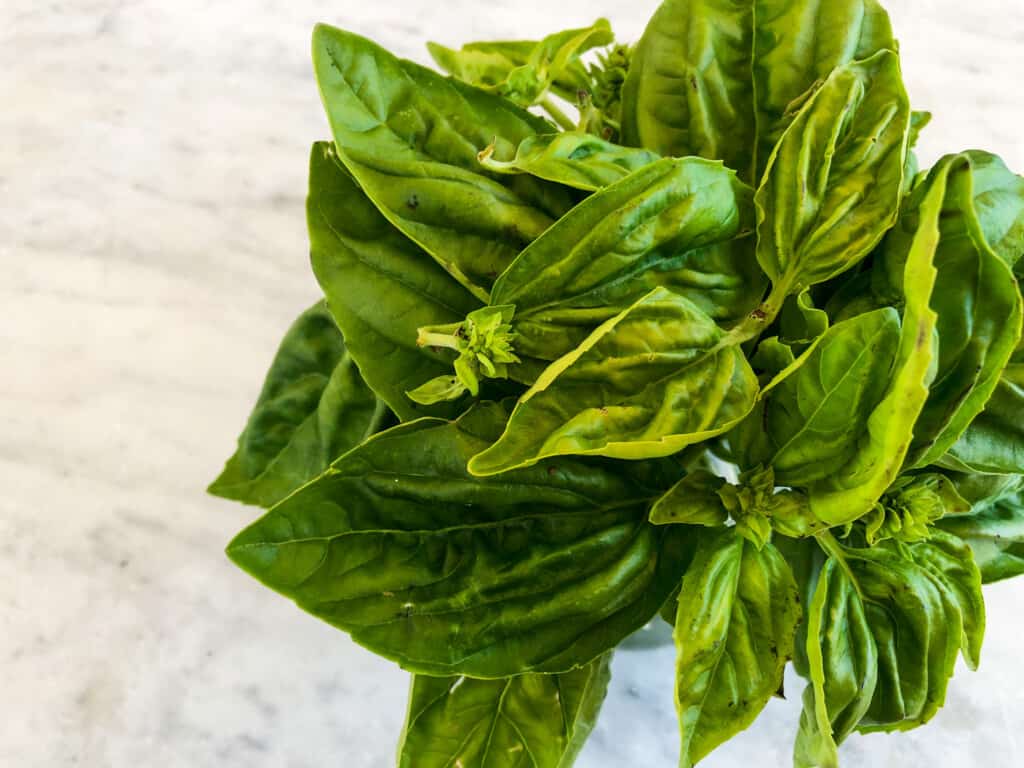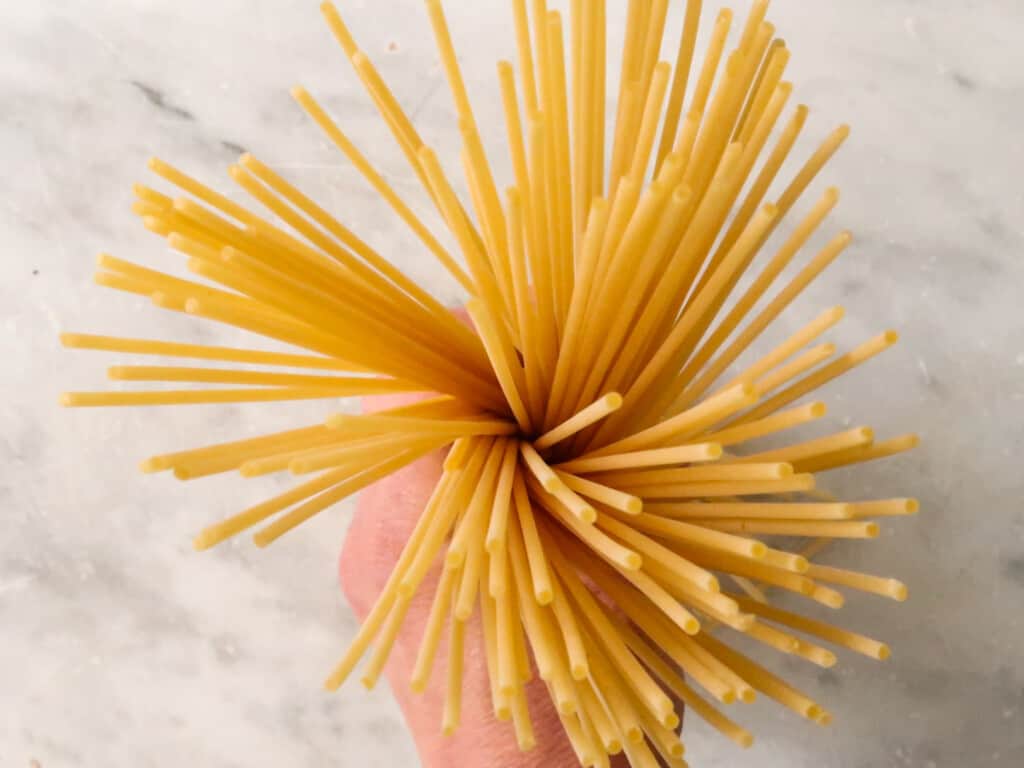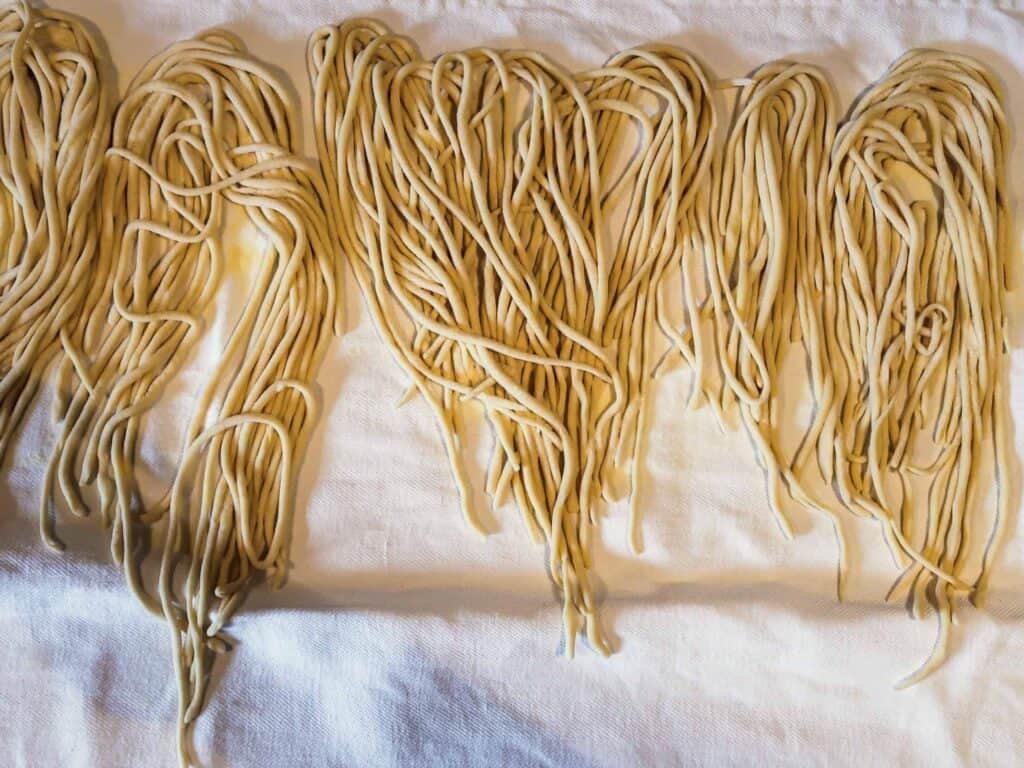Last updated on April 19th, 2024
If you love Italian food or any form of Mediterranean cooking, then you are probably familiar with basil. You might also be wondering how to make basil last for more than 24 hours.
Basil is one of those delicate herbs that goes bad quickly but with a few simple tricks, you will be on the right track to storing fresh basil for days on end.
I grow a lot of basil in my garden here in Italy. In the past, when I purchased fresh basil at the store, I found myself frustrated when it went limp on me after a few short hours of getting it home.
Once I learned this fast trick for storing fresh basil leaves on my counter top, I not only stopped growing as much in my garden but I also found myself using it everywhere as it was just at arm’s reach.
If you find yourself in a similar ‘limp basil’ situation, read on. In this article, I will cover the best method to store fresh cut basil leaves, how to freeze fresh basil and what to avoid to reduce food waste and keep your fresh basil green and lively for longer than you ever thought possible!
Jump to Section
What Is Basil?
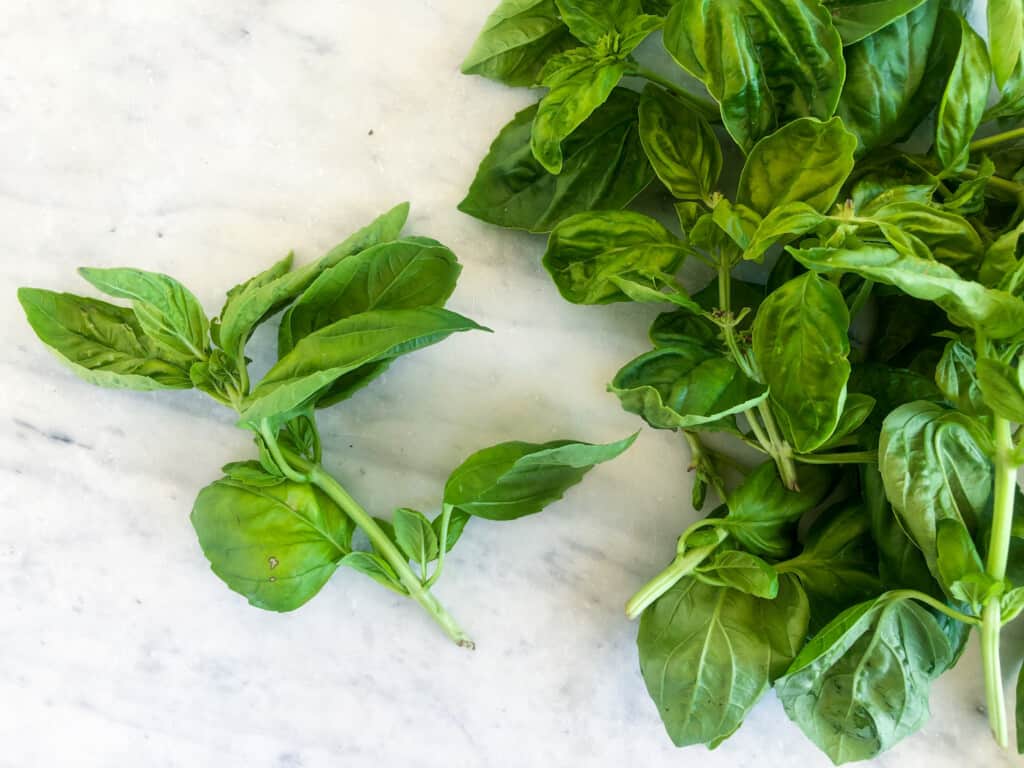
Basil (Ocimum basilicum) is a delicate, tender herb, belonging to the mint family. It has bright or dark green oblong pointed leaves (depending on freshless, variety, growing conditions) with a sweet yet delicate flavor.
Today, basil is grown all over the world in warm locations. In some parts of the world such as in Italy, it can grow for much of the year while in other parts, such as North American, it only does well for a few months.
Basil can be grown either indoors or outdoors but it does best in the ground with full sunlight outdoors.
Basil In Italian
Basil in Italian is basilico, pronounced bah-see-lee-koh.
Listen to the pronunciation of basilico here:
Want to learn more about fresh basil? Read 12 Common Italian Herbs & Spices (& How to Use Them).
Fresh Basil Benefits
So why go through the effort of storing basil correctly?
- If you store fresh basil leaves properly, you are going to maintain as much flavor as possible, maximizing its potential in recipes and cooking.
- Storing fresh basil properly will keep your basil fresh for a longer period, minimizing food waste.
- With the correct storage, fresh basil will hold its color and texture. If basil is stored improperly, it will wilt and can turn brown.
How To Harvest Fresh Basil

It’s best to harvest any herb when it’s dry outside. Gently cut the basil stems from just above nodes on the plant (the crotch where a new outshoot is growing from a fork in the basil stems) and immediately proceed with storing it properly (see below).
Do not use the flowers of fresh basil. You want to use the leaves for cooking.
Nice To Know: If you just need a few leaves, gently remove each leaf independently from the plant. There is no need to cut a whole portion of the basil plant off.
How To Select Fresh Basil
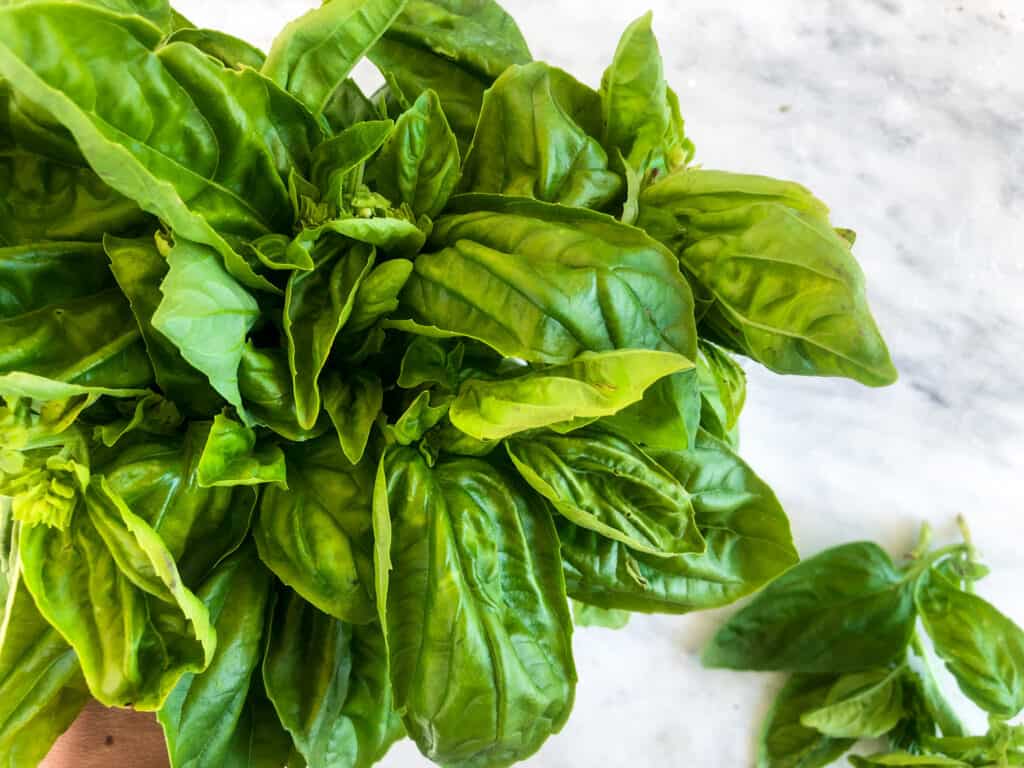
Select basil that is bright green, undamaged and does not have brown or dark spots on it. It should be very aromatic and fresh looking. If there is any sign of wilting, pass on it.
How Long Does Basil Stay Fresh?
If stored properly, fresh basil leaves should stay fresh anywhere from five days to a whole week, depending on their location and the state they were in when they were harvested and purchased.
How To Store Fresh Basil Step-By-Step
Here are two methods for storing fresh cut basil. I prefer the first but you will soon find what best works for you based on your storage space and kitchen layout.
How To Store Fresh Cut Basil In A Jar
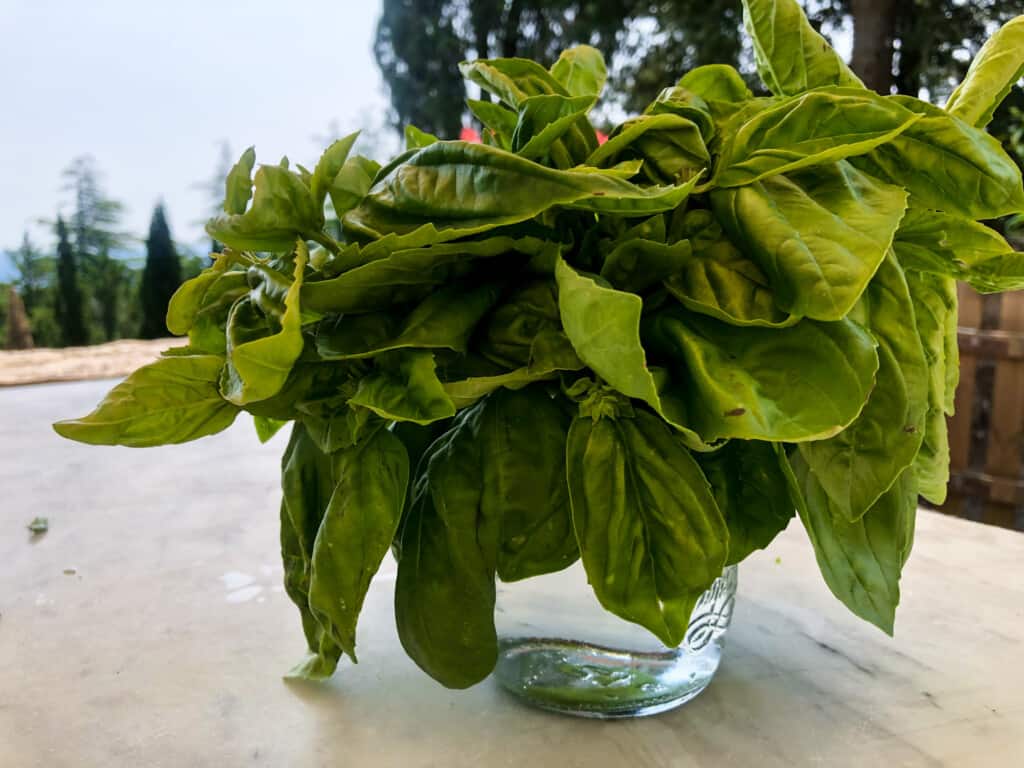
Generally speaking, fresh basil should always be stored at room temperature as long as it is in water. In this method, leave the basil on your kitchen counter top until ready to use.
Cut: Cut the ends off your basil at a diagonal.
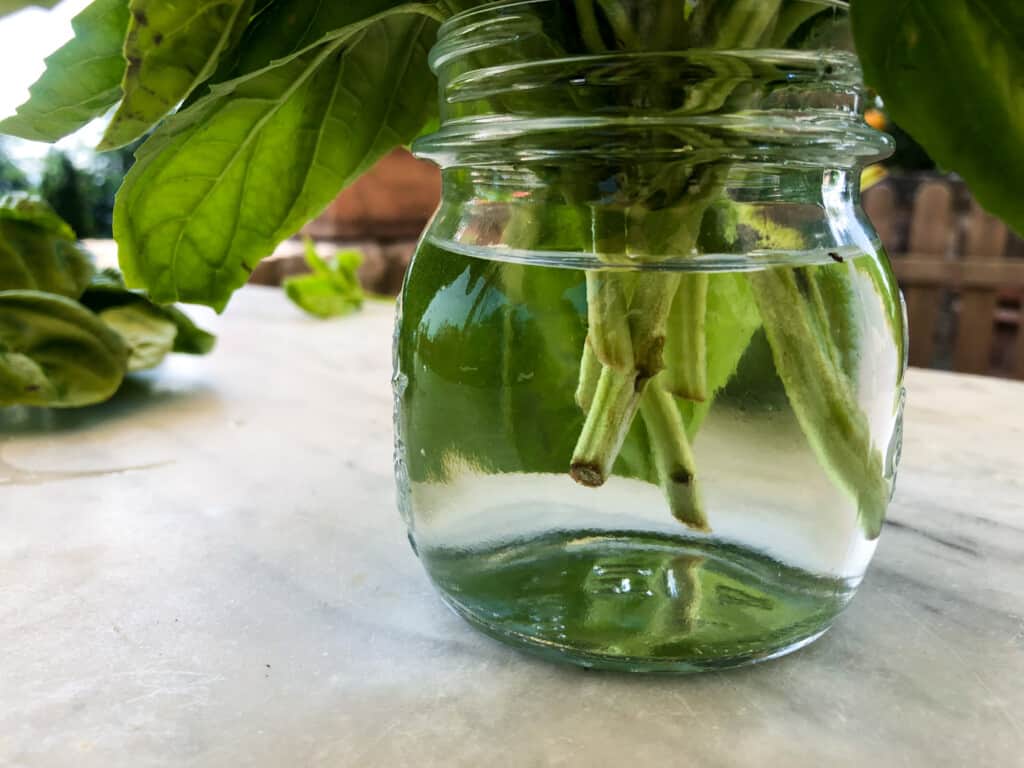
Fill: Fill a glass jar about half way with basil and put your basil standing straight into the jar, being sure the stems are covered by at least one inch of water.
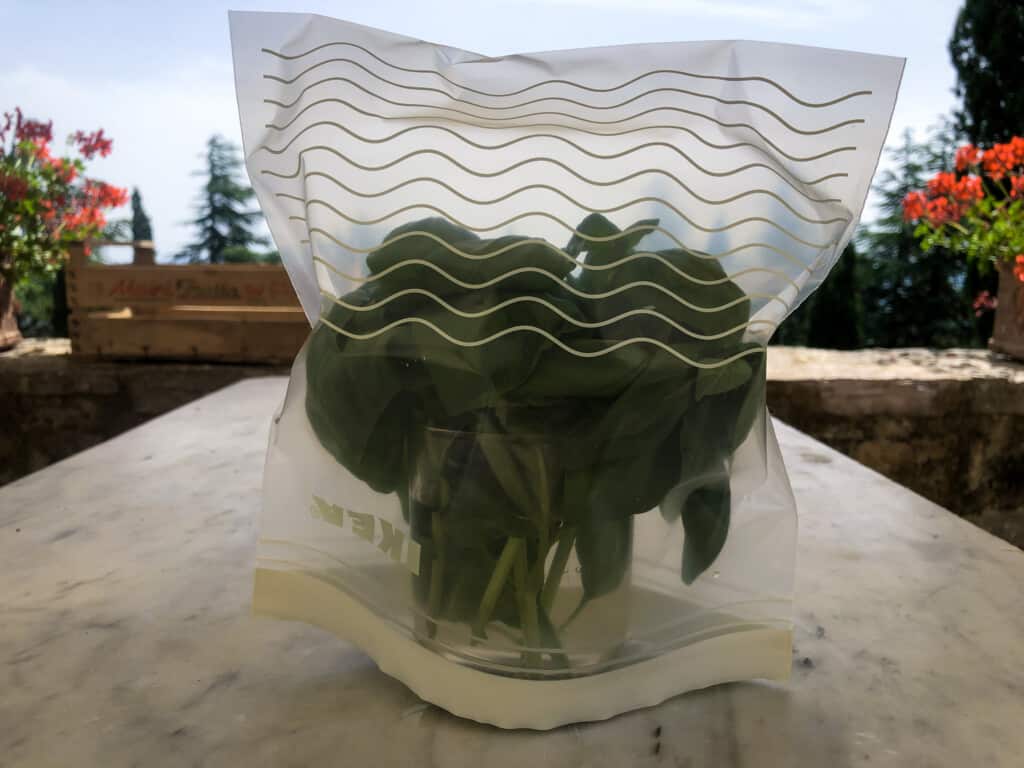
Cover: Loosely cover the top of your fresh basil leaves with a large ziplock bag (I think a quart size usually works best) but do not close, tuck or in any way seal the bottom sides of the plastic bag over the basil bouquet. Make sure the bag is not crushing or cramping the basil leaves.
Enjoy: Place the jar in a spot in your kitchen away from direct heat such as next to your stove. It should also get as much sunlight as possible. I like to keep it above my sink and it reminds me I have it ready to use.
Repeat: Don’t forget about your basil. Check on it everyday, being sure the water hasn’t gone below the cut line. I like to cut the tips off at a diagonal every two days to ensure the fresh basil leaves are receiving ample water.
Good To Know: Do not place your jar of water stored with fresh basil leaves in the refrigerator. The leaves will start to turn brown and will lose their color.
How To Store Fresh Basil Leaves In A Bag
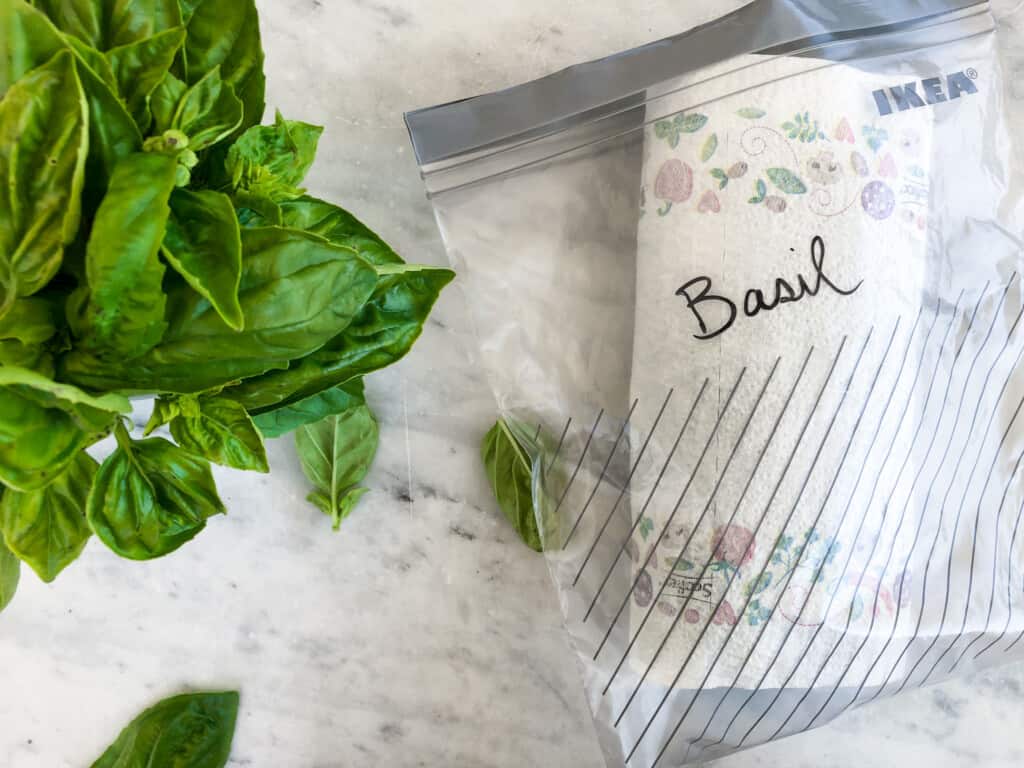
There is one exception to keeping basil in the refrigerator as long as you follow these precise instructions. I find that the basil doesn’t last quite as long and does turn brown after a couple of days. I always prefer the first method in the jar.
Prep: Carefully remove the stems from the basil leaves.
Dry: Be sure the basil is completely dry by patting it with a paper towel or using a salad spinner to remove any excess water.

Roll: Lay the leaves out in a single layer on paper towels and roll gently.
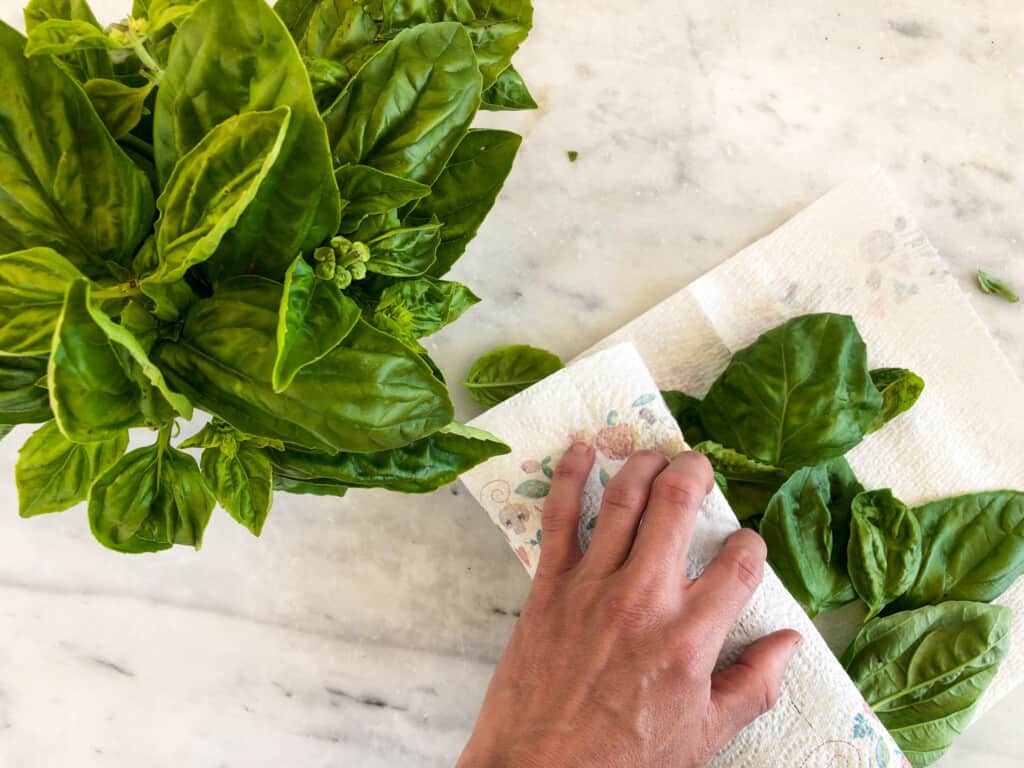
Store: Place in a ziplock bag and store in the refrigerator for up to five days.
How to Freeze Fresh Basil Leaves
You can absolutely freeze fresh cut basil for a burst of summer flavor no matter the season. Follow these simple steps to store your fresh basil leaves in the freezer.
How To Freeze Fresh Basil In Olive Oil
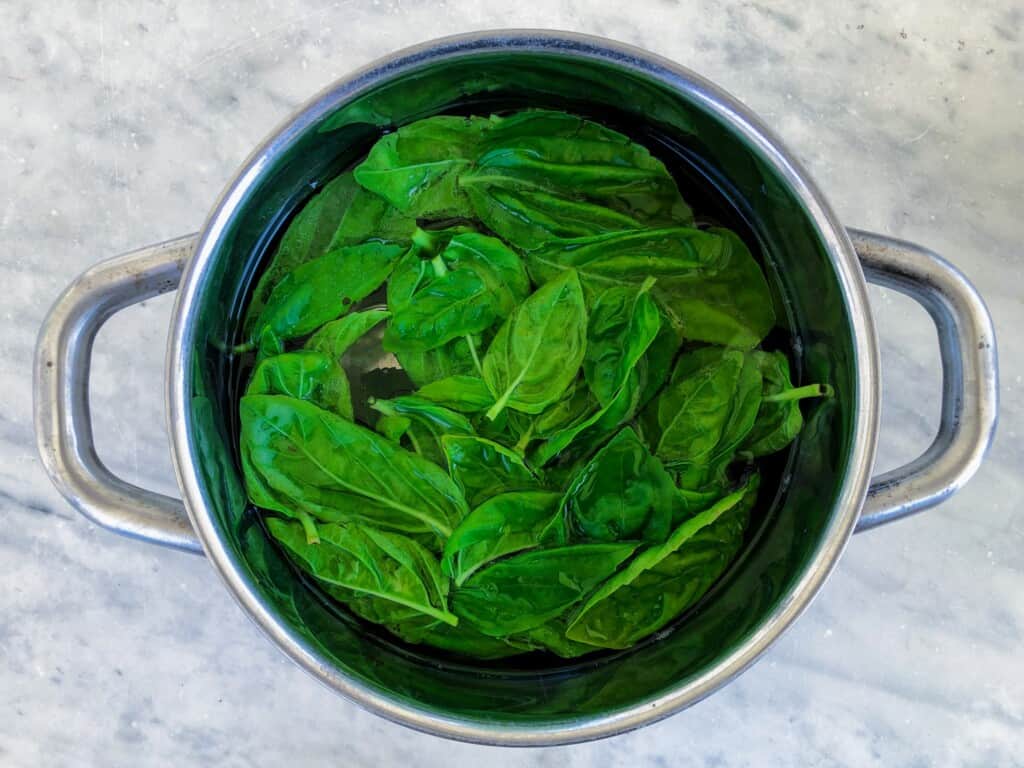
Blanch: You need to blanch the basil leaves to keep them from turning brown. Simple remove the basil from the stems, cook for just a quick 8 seconds in a pot of boiling water and cool them off in an ice water bath to stop the cooking process.
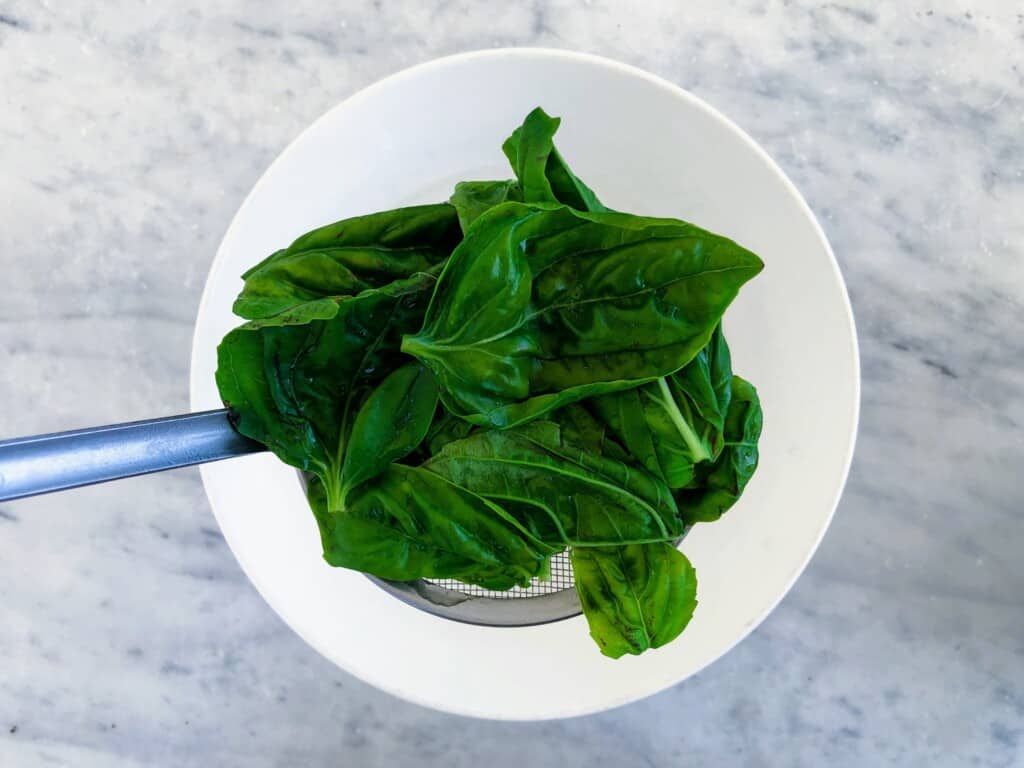
Dry: Dry your blanched fresh basil leaves in a salad spinner for best results. Alternatively, you can pat them dry with a paper towel or a hand towel.

Freeze: Chop the blanched, fresh basil leaves, add just enough oil to coat the leaves. Let freeze in ice cube trays and remove as needed for fresh, summer flavor. Store for up to three months.
How To Freeze Fresh Basil Leaves Whole

Blanch: You need to blanch the basil leaves to keep them from turning brown. Simple remove the basil from the stems, cook for just a quick 8 seconds in a pot of boiling water and cool them off in an ice water bath to stop the cooking process.
Dry: Dry your blanched fresh basil leaves in a salad spinner for best results. Alternatively, you can pat them dry with a paper towel or a hand towel.
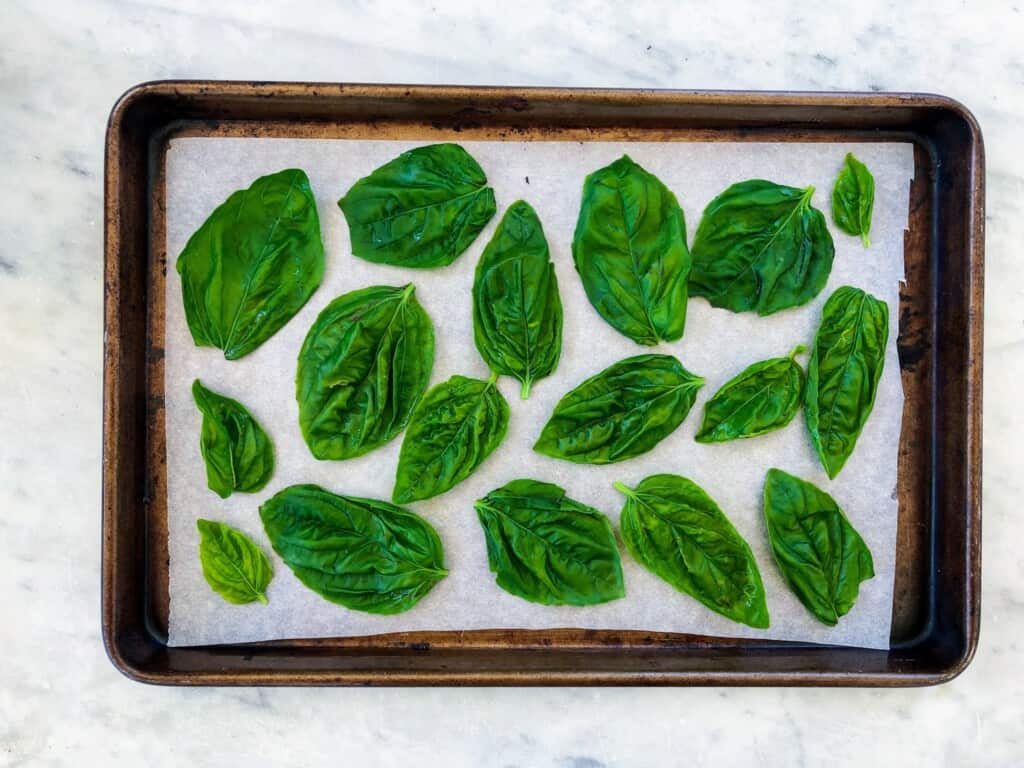
Freeze: Lay out the blanched basil leaves and freeze on a parchment lined tray. They will freeze up pretty quickly and then can be transferred to a ziplock bag and stored for up to three months.

How To Use Frozen Basil Leaves

You can easily take out your fresh basil leaves and add them to dishes such as tomato sauce, pappa al pomodoro or to simply brighten up dishes right at the end of cooking.
Tip: You can also freeze other herbs. Read about Freezing Parsley.
How to Chop Fresh Basil
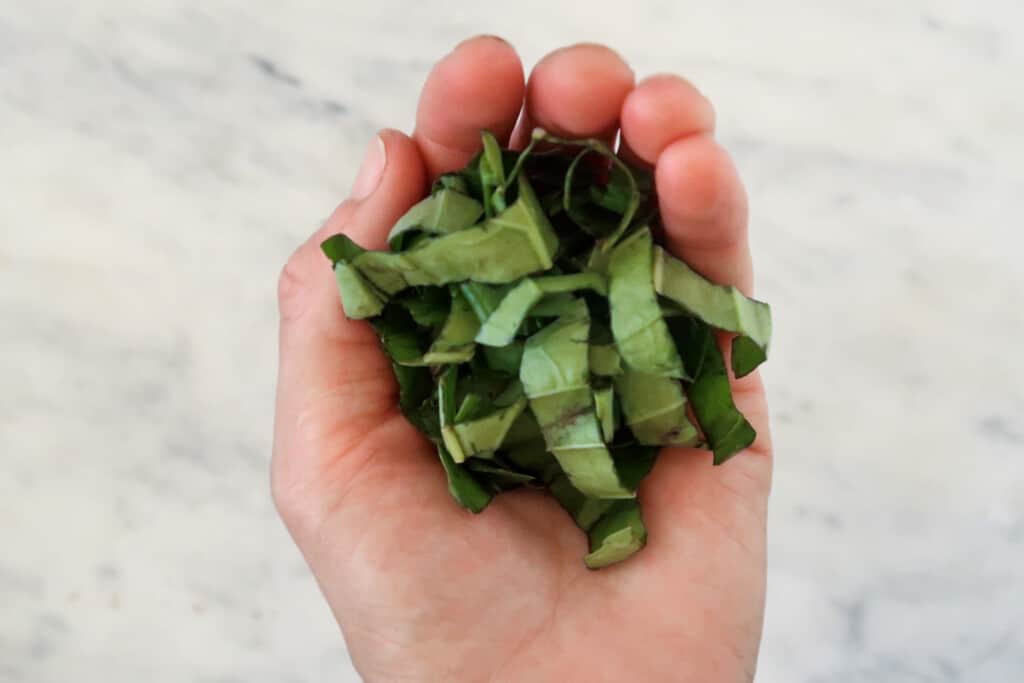
Because basil is a delicate herb and bruises easily, you should always chiffonade it or gently tear it with your hands. Never mince it or chop roughly with a knife.
If you bruise basil, brown and black marks begin to form on the leaves. The flavor of basil also begins to change negatively immediately.
How To Chiffonade Fresh Basil
Stack: Stack the basil leaves into a small pile
Roll: Roll the stacked basil leaves into a type of cigar.
Cut: With a very sharp knife, cut down, applying even pressure as to clearly cut through the rolled basil.
Unravel: Delicately pull apart the ribbons of basil being careful not to handle them too much.
How To Tear Fresh Basil
To tear fresh basil, take one basil leaf in your hands and gently tear or rib small pieces from the leaf into your bowl, being careful not to squeeze the leaf that you are holding.
Serving Tip: Always add fresh basil leaves right before serving. Either chiffonade or tear your basil as a last step. It’s not a step that you can prep-ahead as the flavor and appearance of the basil leaves changes immensely as it sits.
Italian Recipes That Use Fresh Basil
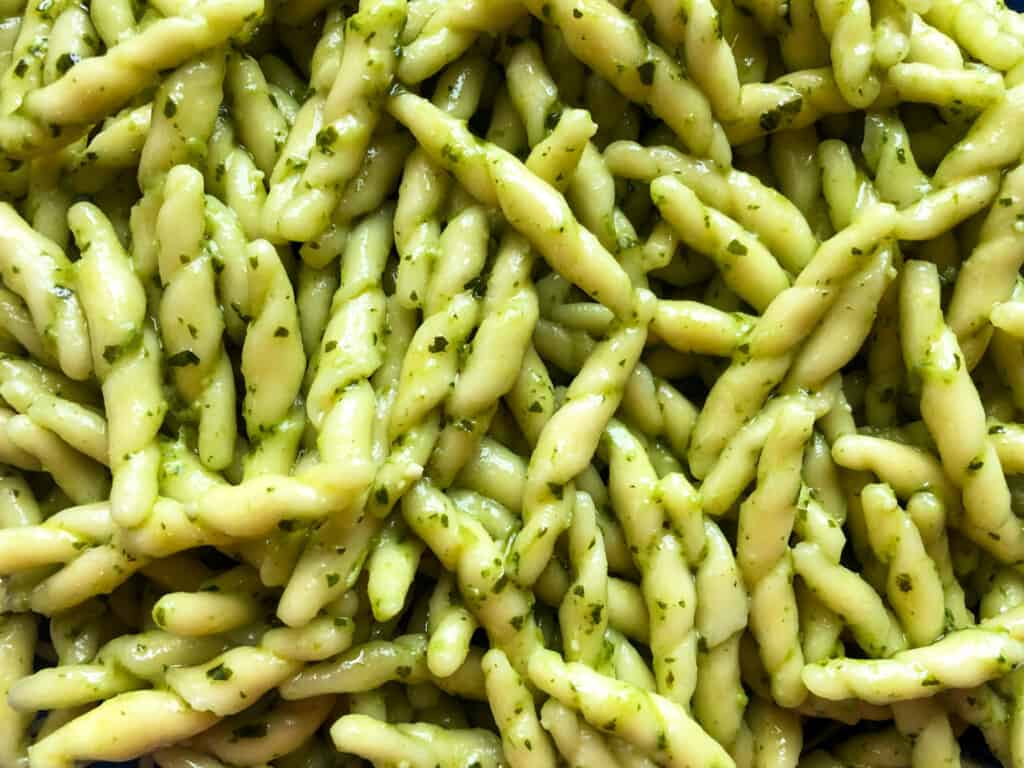
A defining characteristic of Italian cuisine is the use of fresh ingredients, even if it’s just a sprinkle at the end.
Cooking Tip: Adding basil to recipes should be done at the end of the cooking process or added right before serving. When basil is cooked a long time, it loses its flavor.
Popular Italian recipes with basil:
- pesto (Liguria)
- caprese – tomato and mozzarella salad
- pappa al pomodoro – tomato and bread soup (Tuscany)
- pomarola – tomato sauce
- parmigiana di melanzane – eggplant parmesan
- risotto al basilico – basil risotto
- pasta alla norma – pasta with eggplant and tomatoes (Sicily)
- pizza and pinsa
- sugo di pomodoro fresco – fresh tomato sauce
- bruschetta
- panzanella – bread salad with tomatoes (Tuscany)
- frittata – Italian omelet
- lasagna al pesto – pesto lasagna (Liguria)
How To Store Fresh Basil FAQ
Generally speaking, basil should stay at room temperature in a glass of water but you can store it rolled in a paper towel in a ziplock bag for up to 3 days if you do not have the possibility to keep it in a bouquet on the kitchen counter.
Blanch the basil and then freeze in ice cube trays, covered in oil or in a single layer on a baking sheet. They should then be transferred to a ziplock bag for longterm freezer storage. You can also dry basil for even longer storage.
If not stored properly in the refrigerator, basil can wilt and develop brown spots. It will also significantly decrease in flavor. Rather, keep fresh basil stored at room temperature in a small jar or glass of water for up to 5 days.
Yes, you can! You do need to quickly blanch the leaves beforehand and then lay them in a single layer on a baking sheet until frozen. Transfer to a ziplock bag and keep for up to three months in the freezer.
If you want to retain the fresh, summer flavor of basil, it’s best to freeze it. Basil is a delicate herb that changes a lot in flavor when dried. When possible, always freeze fresh basil leaves vs drying them.
